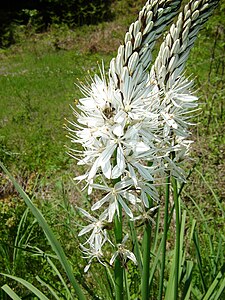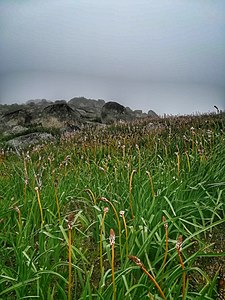Asphodelus albus
| Asphodelus albus | |
|---|---|

| |
| Scientific classification | |
| Kingdom: | Plantae |
| Clade: | Tracheophytes |
| Clade: | Angiosperms |
| Clade: | Monocots |
| Order: | Asparagales |
| Family: | Asphodelaceae |
| Subfamily: | Asphodeloideae |
| Genus: | Asphodelus |
| Species: | A. albus |
| Binomial name | |
| Asphodelus albus | |
| Synonyms | |
| |
Asphodelus albus, common name white asphodel, is a herbaceous perennial plant belonging to the genus Asphodelus.
Description
White asphodel grows to a height of 50–120 centimetres (20–47 in). The plain stem is supported by fleshy, thickened roots (rhizomes). The leaves, which originate from the base of the stem, are gutter-shaped and glaucous (covered by a waxy coating), about 20–22 millimetres (0.79–0.87 in) wide and 50–70 centimetres (20–28 in) long. The white hermaphroditic flowers are funnel-shaped, 4 centimetres (1.6 in) of diameter, with six elongated petals. The flowering period extends from April through June. The egg-shaped yellow-green seed capsules are usually 8–10 millimetres (0.31–0.39 in) in length.[1]
Subspecies
- Asphodelus albus subsp. carpetanus Z. Díaz & Valdés
- Asphodelus albus subsp. delphinensis (Gren. & Godr.) Z. Díaz & Valdés
- Asphodelus albus subsp. occidentalis (Jord.) Z.Díaz & Valdés
- Asphodelus albus subsp. villarsii (Verl. ex Billot) I. Richardson & Smythies
Distribution and habitat
This plant is native to the Mediterranean area. It is commonly found in meadows and heathland of central Spain, southwest France, and along the southern Alps to the western Balkans up to an altitude of 2,000 metres (6,600 ft). It is also found on the African continent, mainly in Libyan territory. Soils with a high lime content are preferred.
In culture
White asphodel is a feature of the Asphodel Meadows. In Ancient Greece, white asphodel was associated with mourning and death.[1] Its presence was held to facilitate the transition of the dead to Elysium.[citation needed]
White asphodel is also known by the name of branched lily or king's spear.[2]
White asphodel roots were used as food staple in ancient Greece: According to Pliny the Elder, one plant could produce up to 80 tubers. Charles de L´ecluse wrote that he saw 200 tubers attached to one plant. Theophrastus mentioned that the roasted stalk and seeds could be used as food as well. Asphodel is supposed to have extended Epimenides life. The custom of planting graves in Greece with asphodel described in 1887 Macmillan's Magazine may have been to provide nourishment to the dead.[2]
It was introduced as an ornamental in England in 1551, and as of 1887 "extensively used in Algeria for the manufacture of alcohol".[2]
- In the mountain range of Montemuro, northern Portugal
- Capsules and seeds
References
- ^ a b "Asphodelus albus". Missouri Botanical Garden. Retrieved 22 February 2021.
- ^ a b c Anonymous (May–October 1887). "Homer the botanist". Macmillan's Magazine. 56. London: Macmillan and Company: 428–436. Retrieved 3 November 2014.
- Pignatti S. - Flora d'Italia - Edagricole – 1982 Vol. III, pag. 346
- Asphodelus albus Plants profile usda.gov
- Asphodelus albus zipcodezoo.com, 7/15/2012
- Asphodelus albus Encyclopædia Britannica
External links
- Biolib n.d. (Czech and English)
- Asphodelus albus n.d., luirig.altervista.org (in Italian)



